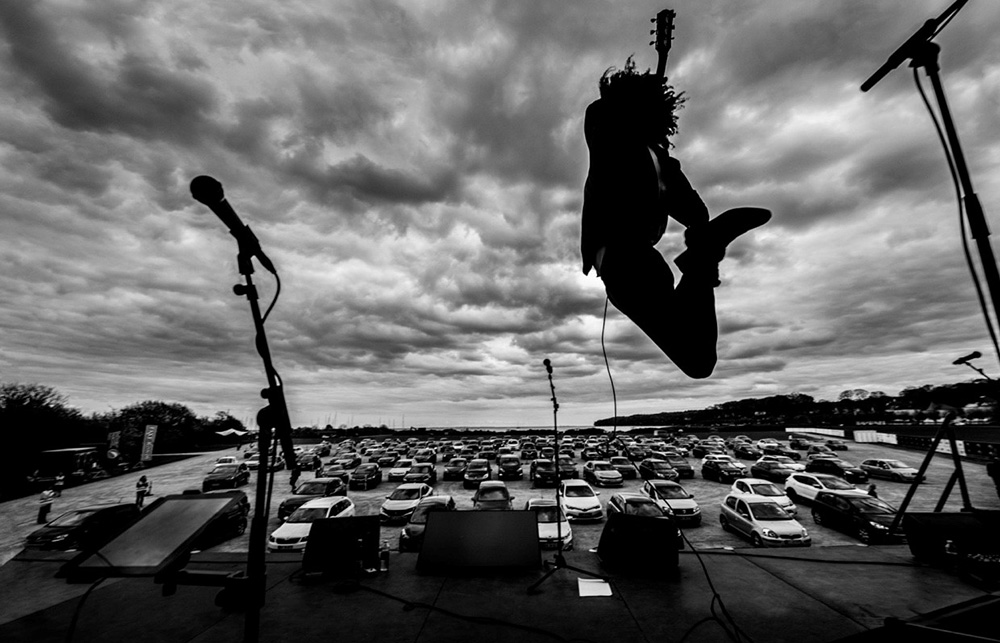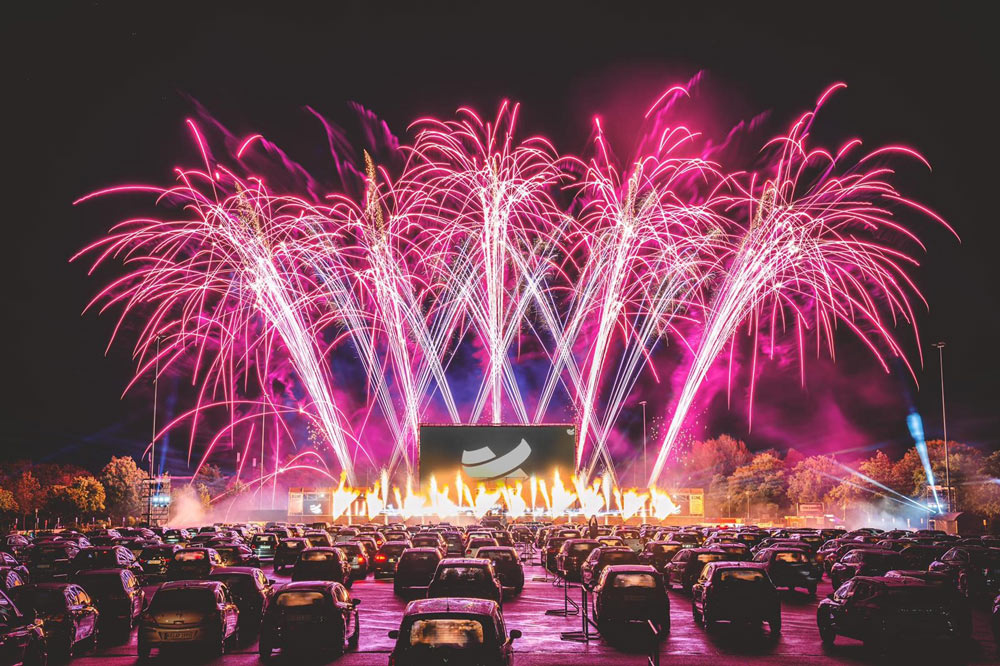身在车中,心在摇滚:疫情时代的现场音乐会

今年3月初,丹麦政府为贯彻封城政策宣布禁止举行音乐会,这让身为音乐家和音乐会主办者的马克·开姆尼茨显得有些不知所措。于是他便与友人集思广益,想出了一个新的,但其实早已风行多年的主意。
“我们只能另寻出路。” 开姆尼茨说,“未来五、六个月,甚至更长时间,我们都不能出去演出。我们对彼此说,我们左右不了疫情,但总不能因为有新冠疫情,就让文化消亡吧。除了对演出形式进行创新,我们别无他法。”
在对已有百年历史的“汽车影院”概念进行重新包装后,他们打造出了现代化、连续举办的“P scenen”文化节。
在奥胡斯市议会的协助下,他们获准在Tangkrogen公园内搭建大型舞台。放在过去,如此规模的舞台前会挤满上万名观众。而在疫情期间,观众则只能坐在数百辆整齐停放的汽车中,透过挡风玻璃和车载FM广播欣赏艺术家的现场表演。
当然,没车也没有关系,梅赛德斯与汽车租赁巨头Europcar提供了崭新的汽车供观众使用,对于同样身处困境的汽车行业而言,这种活动无疑是极佳的营销机会。
首场音乐会于4月24日举行,丹麦著名歌手、词作者麦兹·兰格通过Zoom视频会议接受了观众的演出邀请并在此次音乐会中登台献艺。此后,几乎每天都会有音乐会、独角喜剧、戏剧演出、电影放映和教堂礼拜在内的各种活动。
现在不只是丹麦,德国也有多家活动承办公司开始举办车上狂欢晚会。而这一切的实现则离不开商业模式理念的巨大转变。但还是要再说一次,现场音乐行业现在看起来并没有太多选择余地。
“营收下跌之快令人眼晕”
根据欧洲现场音乐协会提供的数据,该行业去年在欧洲全境的总收入超过了84亿美元。而现在,协会的主席文森佐·斯佩拉称,这一数字很可能会出现约80%的下滑。
他说:“受新冠疫情影响,2月以来,欧洲已有多家音乐公司的营业额出现大幅下滑,速度之快令人眼晕。由于这些公司仍然需要向供应商、雇员、税务机关和银行支付必要款项,这种局面正在耗尽他们手中的流动性。”
斯佩拉还表示,封城期间,现场娱乐行业损失惨重,因为每个人都被告知现在不要进行社交,而 “社交”恰恰是该行业存在的基础。由于现场音乐行业的复杂性“常常不为人知”,他呼吁欧洲各国政府对现场音乐行业的需求给予更多关注。
当被问及对车上音乐会这种活动有什么看法时,斯佩拉说:“这种活动作为权宜之计当然是可行的,但还是取代不了传统音乐会的位置。”他还表示,突然走红的“线上音乐会”也是个办法,但同样解决不了根本问题。”
“我们看到世界各地的艺术家尝试了许多非常棒的方法,但现场活动的震撼之处以及所创造身心体验是这些举措所无法达到的。”斯佩拉说,“有些举措还存在经济和可持续性方面的复杂问题。”
但现场音乐的创新者们并非不清楚这些问题的存在。
新的模式
开姆尼茨的Front of House公司和P scenen 的其他组织者(视听公司Steady和Nordic Rentals)显然需要重新思考现场音乐会的经济性。
相对于可以容纳成千上万名观众的传统音乐节,他们在 Tangkrogen 的场地仅能停放五、六百辆汽车。然而,活动主办方没有为了弥补门票收入而提升票价。他们按车而不是按人收费,还会建议观众仅携自己社交圈之内的亲朋好友一同观看,票价高低则取决于艺术家的知名度。如此一来,门票价格按人计算后通常比以前还便宜。
这种情况的出现很大程度上是音乐节连续举办的结果。开姆尼茨在很多年前就有了这种想法,只不过这次是迫于无奈才实施这一方案。这种做法有效降低了音乐节的制作成本。
“这种经济模式适合于那种持续举行的活动,而非一次性活动。”开姆尼茨说, “挺有意思的,等疫情结束之后我们打算把这种模式应用到其他活动中去。效果真的不错。”
此外,这种音乐节还构建了一种各方合作的架构,让艺术家、活动主办方和承办方都能参与其中。开姆尼茨认为,这种架构可以确保各方在工作中投入更多努力。他表示,如果艺术家能设法卖掉自己音乐会的门票,那么他们的收入将与疫情前相当。
德国电子舞曲巨头BigCityBeats的首席执行官伯恩德·布莱特对于通过车上音乐会赚钱持有不同看法。
BigCityBeats主办的World Club Dome音乐节原计划于今年6月在在法兰克福举行,但因新冠疫情而被迫取消,按照德国政府的规定,8月前不得举行任何大型音乐会。该音乐节原本可以在三天的时间里吸引到约18万名观众到场。

首届World Club Dome车上狂欢晚会于5月1日在杜塞尔多夫举行,虽然现场仅停入500辆汽车,每辆车上最多两人,但活动主办方在制作上依然是全情投入,将其打造成了一场融合烟火、激光表演的盛大演出。
布莱特表示:“这种音乐会最多只能容纳1000名观众,而粉丝又不可能愿意花200到400欧元(相当于217到434美元)来买一张票,所以就更难操作了。最后我们决定将每张票的票价定为40欧元,同时引入一些赞助商来帮我们分担额外成本,从而降低总支出。如果举办方式得宜,这种活动就能在带给粉丝巨大乐趣的同时提升知名度,还可以在这个特殊时期为民众创造一种非常棒的体验……我们没打算赚钱,也没想过要创造一种新的商业模式。”
Breiter hopes clubbers will repay the favor by coming to BigCityBeats' more traditional festivals from next January. 布莱特希望观众明年能来BigCityBeats更为传统的现场音乐节捧场,通过亲临现场来回馈公司今年奉上的精彩演出。
全新体验
显然,对观众而言,车上音乐会不是他们习以为常的事物,但也确实为创新提供了新的途径。
以World Club Dome车上狂欢晚会为例,DJ便在表演中添加了汽车鸣笛和车灯闪烁的元素。坐在车中的现场观众可以通过与表演者同步操作来获得互动体验。
"Judging by the WorldClubbers' reactions, they absolutely loved it," says Breiter. “从到场观众的反应来看,他们显然很喜欢这种感觉。”布莱特说。
在奥胡斯举办的P scenen音乐节的体验虽然与之颇为不同,但同样让人拍手叫绝。因为演出声音信号直接通过老式无线电传输到现场观众的汽车之中,所以演出现场显得非常安静。
开姆尼茨表示,通过采用这种方式,他们得以在不影响周边居民的情况下举办大型演出。新的模式也带来了全新的声音效果。由于无需担心环境噪声或相位效应的影响,所以无论观众坐在哪里,都不会出现声音质量下降的问题。而且由于没有巨型音响系统,不会产生话筒回音问题,所以可以使用更灵敏的高级电容式麦克风。
“我们可以将其布置得跟工作室一样……所有的声音都会非常清晰。”开姆尼茨说。
当然,需要保持社交疏离的不仅是观众,在舞台上表演的演职人员也是如此。而规模较大的乐团要想做到这一点也得有点创意才行。
“我们在周日举办了一场有合唱团参加的福音教堂礼拜活动。” 开姆尼茨说,“因为台上只允许站10个人,所以我们就把合唱团安排在了舞台前的车上。我们安排摄像师绕着汽车拍摄,然后再把视频画面投放到屏幕上。为了方便牧师、合唱团与民众互动,我们还用上了Zoom。”
开姆尼茨还提到,有个12岁的小朋友因为在家憋久了,出现了非常严重的焦虑症状,而儿童音乐会是他在封城之后首次能在一个安全的环境中加入狂欢人群,当时他贴着父亲汽车的挡风玻璃流出了开心的泪水。
他说:“这种活动为全新人群带来了全新的体验。”(财富中文网)
译者:Feb
今年3月初,丹麦政府为贯彻封城政策宣布禁止举行音乐会,这让身为音乐家和音乐会主办者的马克·开姆尼茨显得有些不知所措。于是他便与友人集思广益,想出了一个新的,但其实早已风行多年的主意。
“我们只能另寻出路。” 开姆尼茨说,“未来五、六个月,甚至更长时间,我们都不能出去演出。我们对彼此说,我们左右不了疫情,但总不能因为有新冠疫情,就让文化消亡吧。除了对演出形式进行创新,我们别无他法。”
在对已有百年历史的“汽车影院”概念进行重新包装后,他们打造出了现代化、连续举办的“P scenen”文化节。
在奥胡斯市议会的协助下,他们获准在Tangkrogen公园内搭建大型舞台。放在过去,如此规模的舞台前会挤满上万名观众。而在疫情期间,观众则只能坐在数百辆整齐停放的汽车中,透过挡风玻璃和车载FM广播欣赏艺术家的现场表演。
当然,没车也没有关系,梅赛德斯与汽车租赁巨头Europcar提供了崭新的汽车供观众使用,对于同样身处困境的汽车行业而言,这种活动无疑是极佳的营销机会。
首场音乐会于4月24日举行,丹麦著名歌手、词作者麦兹·兰格通过Zoom视频会议接受了观众的演出邀请并在此次音乐会中登台献艺。此后,几乎每天都会有音乐会、独角喜剧、戏剧演出、电影放映和教堂礼拜在内的各种活动。
现在不只是丹麦,德国也有多家活动承办公司开始举办车上狂欢晚会。而这一切的实现则离不开商业模式理念的巨大转变。但还是要再说一次,现场音乐行业现在看起来并没有太多选择余地。
“营收下跌之快令人眼晕”
根据欧洲现场音乐协会提供的数据,该行业去年在欧洲全境的总收入超过了84亿美元。而现在,协会的主席文森佐·斯佩拉称,这一数字很可能会出现约80%的下滑。
他说:“受新冠疫情影响,2月以来,欧洲已有多家音乐公司的营业额出现大幅下滑,速度之快令人眼晕。由于这些公司仍然需要向供应商、雇员、税务机关和银行支付必要款项,这种局面正在耗尽他们手中的流动性。”
斯佩拉还表示,封城期间,现场娱乐行业损失惨重,因为每个人都被告知现在不要进行社交,而 “社交”恰恰是该行业存在的基础。由于现场音乐行业的复杂性“常常不为人知”,他呼吁欧洲各国政府对现场音乐行业的需求给予更多关注。
当被问及对车上音乐会这种活动有什么看法时,斯佩拉说:“这种活动作为权宜之计当然是可行的,但还是取代不了传统音乐会的位置。”他还表示,突然走红的“线上音乐会”也是个办法,但同样解决不了根本问题。”
“我们看到世界各地的艺术家尝试了许多非常棒的方法,但现场活动的震撼之处以及所创造身心体验是这些举措所无法达到的。”斯佩拉说,“有些举措还存在经济和可持续性方面的复杂问题。”
但现场音乐的创新者们并非不清楚这些问题的存在。
新的模式
开姆尼茨的Front of House公司和P scenen 的其他组织者(视听公司Steady和Nordic Rentals)显然需要重新思考现场音乐会的经济性。
相对于可以容纳成千上万名观众的传统音乐节,他们在 Tangkrogen 的场地仅能停放五、六百辆汽车。然而,活动主办方没有为了弥补门票收入而提升票价。他们按车而不是按人收费,还会建议观众仅携自己社交圈之内的亲朋好友一同观看,票价高低则取决于艺术家的知名度。如此一来,门票价格按人计算后通常比以前还便宜。
这种情况的出现很大程度上是音乐节连续举办的结果。开姆尼茨在很多年前就有了这种想法,只不过这次是迫于无奈才实施这一方案。这种做法有效降低了音乐节的制作成本。
“这种经济模式适合于那种持续举行的活动,而非一次性活动。”开姆尼茨说, “挺有意思的,等疫情结束之后我们打算把这种模式应用到其他活动中去。效果真的不错。”
此外,这种音乐节还构建了一种各方合作的架构,让艺术家、活动主办方和承办方都能参与其中。开姆尼茨认为,这种架构可以确保各方在工作中投入更多努力。他表示,如果艺术家能设法卖掉自己音乐会的门票,那么他们的收入将与疫情前相当。
德国电子舞曲巨头BigCityBeats的首席执行官伯恩德·布莱特对于通过车上音乐会赚钱持有不同看法。
BigCityBeats主办的World Club Dome音乐节原计划于今年6月在在法兰克福举行,但因新冠疫情而被迫取消,按照德国政府的规定,8月前不得举行任何大型音乐会。该音乐节原本可以在三天的时间里吸引到约18万名观众到场。
首届World Club Dome车上狂欢晚会于5月1日在杜塞尔多夫举行,虽然现场仅停入500辆汽车,每辆车上最多两人,但活动主办方在制作上依然是全情投入,将其打造成了一场融合烟火、激光表演的盛大演出。
布莱特表示:“这种音乐会最多只能容纳1000名观众,而粉丝又不可能愿意花200到400欧元(相当于217到434美元)来买一张票,所以就更难操作了。最后我们决定将每张票的票价定为40欧元,同时引入一些赞助商来帮我们分担额外成本,从而降低总支出。如果举办方式得宜,这种活动就能在带给粉丝巨大乐趣的同时提升知名度,还可以在这个特殊时期为民众创造一种非常棒的体验……我们没打算赚钱,也没想过要创造一种新的商业模式。”
Breiter hopes clubbers will repay the favor by coming to BigCityBeats' more traditional festivals from next January. 布莱特希望观众明年能来BigCityBeats更为传统的现场音乐节捧场,通过亲临现场来回馈公司今年奉上的精彩演出。
全新体验
显然,对观众而言,车上音乐会不是他们习以为常的事物,但也确实为创新提供了新的途径。
以World Club Dome车上狂欢晚会为例,DJ便在表演中添加了汽车鸣笛和车灯闪烁的元素。坐在车中的现场观众可以通过与表演者同步操作来获得互动体验。
"Judging by the WorldClubbers' reactions, they absolutely loved it," says Breiter. “从到场观众的反应来看,他们显然很喜欢这种感觉。”布莱特说。
在奥胡斯举办的P scenen音乐节的体验虽然与之颇为不同,但同样让人拍手叫绝。因为演出声音信号直接通过老式无线电传输到现场观众的汽车之中,所以演出现场显得非常安静。
开姆尼茨表示,通过采用这种方式,他们得以在不影响周边居民的情况下举办大型演出。新的模式也带来了全新的声音效果。由于无需担心环境噪声或相位效应的影响,所以无论观众坐在哪里,都不会出现声音质量下降的问题。而且由于没有巨型音响系统,不会产生话筒回音问题,所以可以使用更灵敏的高级电容式麦克风。
“我们可以将其布置得跟工作室一样……所有的声音都会非常清晰。”开姆尼茨说。
当然,需要保持社交疏离的不仅是观众,在舞台上表演的演职人员也是如此。而规模较大的乐团要想做到这一点也得有点创意才行。
“我们在周日举办了一场有合唱团参加的福音教堂礼拜活动。” 开姆尼茨说,“因为台上只允许站10个人,所以我们就把合唱团安排在了舞台前的车上。我们安排摄像师绕着汽车拍摄,然后再把视频画面投放到屏幕上。为了方便牧师、合唱团与民众互动,我们还用上了Zoom。”
开姆尼茨还提到,有个12岁的小朋友因为在家憋久了,出现了非常严重的焦虑症状,而儿童音乐会是他在封城之后首次能在一个安全的环境中加入狂欢人群,当时他贴着父亲汽车的挡风玻璃流出了开心的泪水。
他说:“这种活动为全新人群带来了全新的体验。”(财富中文网)
译者:Feb
When Denmark's government banned concerts as a lockdown measure in early March, musician and event organizer Mark Chemnitz wasn't sure what to do. So he and his friends brainstormed and came up with a new—yet decidedly old-fashioned—idea.
"We had to rethink the whole game," Chemnitz says. "None of us could go out and play any gigs for the next five or six months, maybe longer. We said to each other, just because there's COVID-19, that doesn't mean culture is dead…You can't hold it in. We did it because we had no other choice."
What they did was to repurpose the century-old concept of the drive-in theater as a modern-day, continuous culture festival, called P scenen.
With assistance from the council in the city of Aarhus, they gained permission to set up a large stage in the Tangkrogen public park. Once, such a stage might have had 10,000 people thronging before it. Now, in the age of the coronavirus, the audience would sit encased in hundreds of cars, spaced out in neat rows, with their occupants enjoying the live entertainment through their windscreens and tuned to their FM radios.
For those without vehicles of their own, Mercedes and rental giant Europcar provided new cars for people to sit in—a neat marketing opportunity for an industry that is itself in crisis.
The first concert took place on April 24, featuring the popular Danish singer-songwriter Mads Langer, who took audience requests through a Zoom videoconference. Since then, events have taken place most days, ranging from concerts, stand-up comedy and theater productions to film screenings and church services.
The idea isn't just confined to Denmark; in Germany, multiple club promoters have started holding drive-in raves. This all requires a big shift in thinking around business models. But, again, it's not like the live music industry has much choice right now.
"A dizzying drop"
According to the European Live Music Association, the sector drew in more than $8.4 billion across the continent last year. Now, says association president Vincenzo Spera, that figure will likely drop by around 80%.
"With the COVID-19 crisis, many music companies across Europe have been experiencing a dizzying drop in turnover since February, which is draining liquidity, against [necessary payments to] suppliers, employees, tax authorities and banks," he says.
Spera says the sector is being particularly "penalized" during lockdown because live entertainment is inherently social—which is what we're all being told not to be. He calls for European governments to pay more attention to the live-music industry's needs, as its complexities are "often little known."
And what of ideas such as drive-in concerts? "This is mostly a working hypothesis that certainly cannot replace the typical use of concerts," says Spera, while arguing that the suddenly-popular phenomenon of livestreamed concerts is "also an option, but it cannot be the solution."
"We are seeing many important initiatives by artists from all over the world, but it is difficult to think of replacing the emotional charge and the consequent physical and emotional experience that the live event brings," says Spera. "Then there is the complex issue linked to the economic sustainability of certain proposals."
But neither of these factors is lost on live music's new innovators.
New models
Chemnitz's Front of House company and the other P scenen organizers—audiovisual firms Steady and Nordic Rentals—have certainly had to rethink the economics of live music.
Whereas a regular festival might pull in many thousands of people, they can only get 500-600 cars onto the Tangkrogen field. But the organizers are not charging more per ticket to compensate. They charge per car rather than per person—the recommendation is that people only bring the close friends or family members in their social bubble—with the price varying according to the prominence of the artist. And the result is that it generally works out cheaper for each person to attend, not more expensive.
This is largely because of the continuous nature of the festival—an idea Chemnitz says he had been toying with for years before it was forced into reality. This drives down the capital costs of the production.
"The economic model works over time, but not as a one-off," Chemnitz says. "That is very interesting, because when we get on the other side of this, we will apply this model to other festivals. It works really well."
The festival is also structured as a type of cooperative effort, where artists, organizers and promoters all have a stake. Chemnitz argues that this ensures the participants all work harder. If artists manage to sell out their concerts, he says, they earn much the same as they would have done in former times.
Bernd Breiter, the CEO of German electronic dance music giant BigCityBeats, has a different take on the issue of making money through drive-in concerts.
BigCityBeats' World Club Dome festival was due to take place in Frankfurt in June, before the coronavirus forced its cancellation—Germany's government won't allow any big concerts until August at the earliest. It would have drawn in 180,000 clubbers over three days.
The first World Club Dome Drive-In rave, which took place in Düsseldorf on May 1, could only take in 500 cars, with up to two people in each. Meanwhile, the organizers still went all-in on creating a huge show, involving fireworks and lasers.
"This makes it harder, because we're limited to 1,000 people, and we would never expect our fans to pay €200-€400 [$217-$434] a ticket," says Breiter. "So we made a decision to charge €40 per ticket, and we brought in some sponsors to help with the extra costs. This brought down the totals. However if you host an event like this correctly, you can offer fans huge amounts of fun, raise awareness and provide a great feeling during such a strange time...We weren’t looking to make money, or develop a business model."
New experiences
The drive-in concert experience is obviously not what people are used to, but it does provide new avenues for creativity.
In the case of World Club Dome Drive-In, the DJs added elements such as car horns and flashing indicators to their performances. The crowd, sitting in their cars, synced up to the performers for a communal experience.
Aarhus's P scenen festival experience is quite different, though no less remarkable. There, quietness is the order of the day, due to the use of old-school radio transmissions right into concert-goers' cars.
According to Chemnitz, this makes it possible to put on a big show without bothering residents in nearby properties too much. It also has huge implications for sound production. There's no need to worry about the acoustics of the environment or the phasing effect that can result in people hearing a washy sound, depending on where they are sitting or standing. And because there is none of the microphone feedback that would be associated with a giant sound system, it is possible to use more sensitive, high-grade condenser microphones.
"We could make it into a studio setup… Everything is crystal clear," Chemnitz says.
Of course, it's not just the audience that needs to adhere to social distancing—the same applies to the performers on the stage. For larger ensembles, that requires an extra layer of creativity.
"On Sunday we had a gospel church service with a choir," Chemnitz says. "We can only have 10 people on stage, so we put the choir in cars in front of the stage. We had the camera people going around the cars, filming them and showing them onscreen. And for the preacher and the choir to interact with people, we had the Zoom app."
Chemnitz says that, during a children's concert, one 12-year-old boy was pressed up against the windscreen of his father's car, crying happy tears—he suffered from intense anxiety and was for the first time able to be part of a festival crowd, while in a safe space.
"It's opened up the experience to a whole new segment of people," he says.













